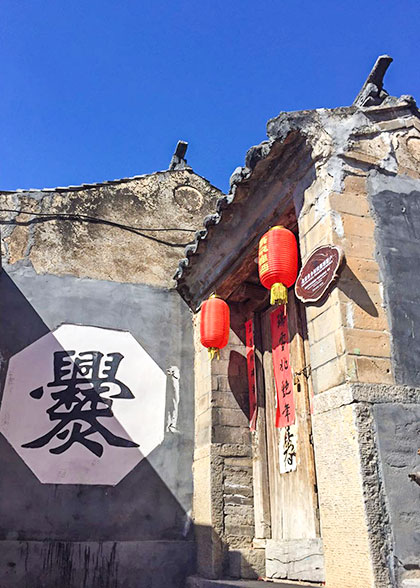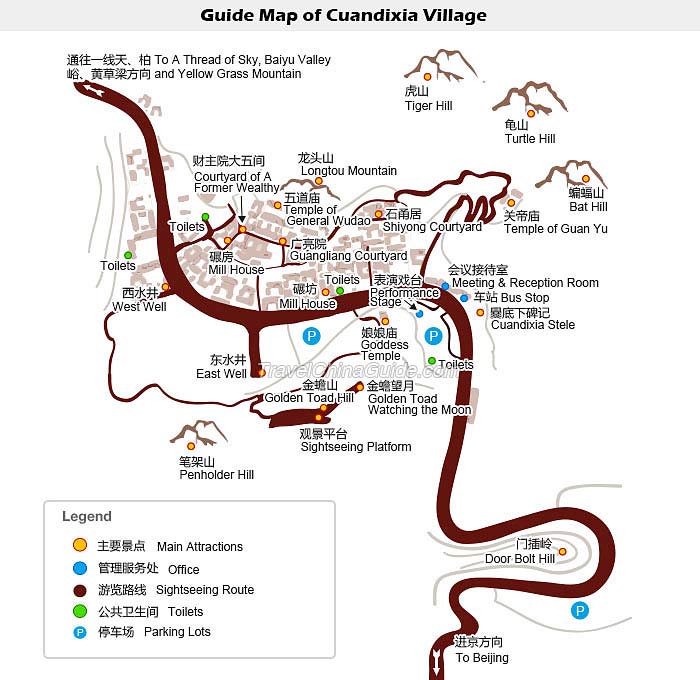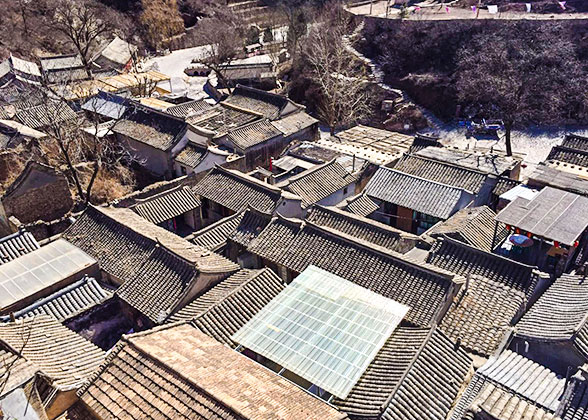Situated in Zhaitang Town, Mentougou District, Cuandixia Village (or Chuandixia Village) is about 56 miles (90 km) west of downtown Beijing. Traditional dwelling complexes, colorful historical relics, and unique folk customs characterize this ancient village, surrounded by mountainous landscape.
History
The village has a history of over 500 hundred years, which can be dated back to the
Ming Dynasty (1368 - 1644). It used to be prosperous, but today, only 76 courtyards have survived natural erosion and gunpowder. In total, 29 families still inhabit the village. Although bereft of past glamour, the primitiveness and simplicity of the village has attracted more and more visitors in recent years.
Name Origins
 |
| Beijing Cuandixia Village |
There are many legends about the village's name. The most convincing one is that the village was located below an important military pass, Cuanli'an Pass, hence the name Cuandixia, meaning village below Cuanli'an Pass. Another legend has it that Cuan (爨) in ancient Chinese means stove; the villagers named their dwelling as 'a place under stove' to help them stay away from coldness. All villagers' surnames are Han (韩), a Chinese character homophonic with the character 寒, which means coldness; their ancestors gave them the name to defend against the cold days.
Village Layout
The village was built following the terrain of Longtou Mountain slopes, and is 'sycee' shaped from a bird's eye view. From the top point of the mountain range, the courtyards were arranged in a radial direction down to the foot. Flat ground was very limited, all the houses are crammed in anywhere, and everywhere possible. People took full advantage of every strip of mountain land to build their dwellings so that more land would be given for farming. Those times were ones of post-war famine.
Why the village was built there is related to Chinese
Feng Shui. According to the rules, an auspicious site should lean against a stable mountain, face a lower mountain with rolling hills on two sides. The location of the village meets these conditions, with Longtou Mountain to rely on, lower Jinchan Mountain in front, and other small hills surrounding. All these were believed to be auspicious factors, which enabled the village to survive natural disasters like floods.
 |
| Guide Map of Cuandixia Village |
Courtyard
Most of the houses in the village are quadrangle courtyards, which usually consists of main hall to the north side, wing rooms at west and east sides, as well as guest houses to the south; typical of
Beijing courtyards. They have unique features, but due to space limitation, are smaller than those in downtown Beijing. They are delicate as well, built on mountain slopes, and limited by the local terrain. They may not be exactly square and are more flexible in shape; the houses were built with local materials like wood and stone. In addition, most the houses' outside corner, fence wall, stylobate, and gate pier are in cambered shape, which improves flood control. They also reduce the flood's damage to the house. In the whole village, there are several well-preserved courtyards worth visiting, such as Guangliang Courtyard, Caizhu Courtyard, Temple of General Wudao, Temple of Guanyu, Goddess Temple and Mill House.
 | | A Bird-eye View of the Village | |  | | Courtyards in the Village | |
Decoration
Inside the courtyards, visitors can find many delicate brick, stone, and wood carvings, especially on the roof, eaves, gate pier, wall, and windows. Most carving patterns are flowers, birds, or animals, which indicate the local people's desire for a tranquil life. The decorations vary a lot from one courtyard to another, and visitors can tell the owner's economic status by the finery and intricacy of decorations. In Cuandixia Village, Guangliang Courtyard is the most renowned.
Folk Customs
Cuandixia Village is an interesting place to experience during
Chinese New Year. It retains all the original customs, such as eating dumplings, setting off fireworks, and striking the New Year bell. There, visitors can bathe in a denser festival atmosphere than in modern cities. When the
Lantern Festival comes, villagers will offer sacrifices to gods, and send colorful lanterns as boats or balloons for good luck. The
Qingming Festival is a very special day for local people, when the most popular activities are honoring the memory of ancestors, and have a ride on swing. In leisure time, villagers will hold story-telling and ballad-singing activities; most of them quoting from classical literature, local Chinese Opera, or historical novels. Their traditional culture and art are inherently associated with daily life in a beguiling and interesting way.
Nearby Scenic Spots
About 0.7 miles (1,127m) walking distance to the village, there is a natural beauty spot named Yixiantian, which means a thread of sky, which can be viewed through two closely-located mountains. Baiyu Village, an old village with several hundred years' history, is about 3 miles (5km) to the west of Cuandixia Village.
How to get to Cuandixia Village
Take
Subway Line 1 or
Line 6 to Pingguoyuan Station. Then take bus M11, M22 to Zhaitang Station, transfer to M12 to the village.
Note that M11 departs at 6:55, 12:30 and 17:00 every day at Pingguoyuan Subway Station, and M12 departs at 6:20, 9:20 and 14:00 at Zhaitang Bus Station.
Tips:
 Admission Fee: free
Admission Fee: free
Opening Hours: 24 hours open

Accommodation: The courtyards in the village provide rooms for visitors at the price of CNY100-200.

Shopping:
Before leaving, one can buy souvenirs or local specialty. Here are some popular ones.
Souvenirs: Mini tile, lanterns, paper cut, tile carving, wood carving.
Local Specialties: walnut, almond, camellia tea, honey, dried fruits.

Other Attractions in Mentougou, Beijing:
 Mount Miaofeng
Mount Miaofeng Tanzhe Temple
Tanzhe Temple Jietai Temple
Jietai Temple Lingshui Village
Lingshui Village Lingshan Mountain
Lingshan Mountain Western Hills Forest Park
Western Hills Forest Park Weekend Trips from Beijing
Weekend Trips from Beijing 10 Non Touristy Things to Do in Beijing
10 Non Touristy Things to Do in Beijing- Last updated on Aug. 20, 2024 by Gabby Li -



